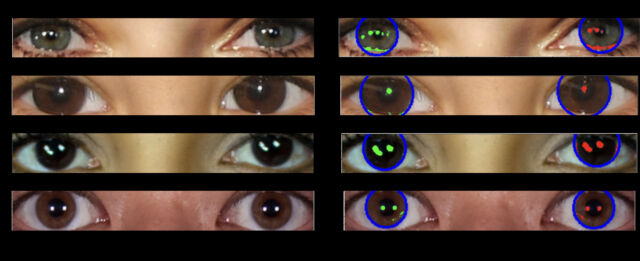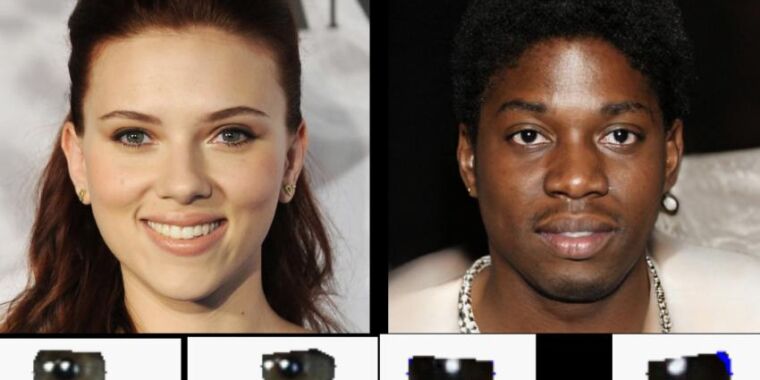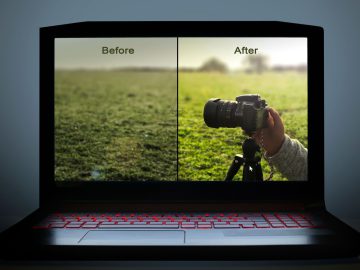Enlarge / Researchers write, “In this image, the person on the left (Scarlett Johansson) is real, while the person on the right is AI-generated. Their eyeballs are depicted underneath their faces. The reflections in the eyeballs are consistent for the real person, but incorrect (from a physics point of view) for the fake person.”
In 2024, it’s almost trivial to create realistic AI-generated images of people, which has led to fears about how these deceptive images might be detected. Researchers at the University of Hull recently unveiled a novel method for detecting AI-generated deepfake images by analyzing reflections in human eyes. The technique, presented at the Royal Astronomical Society’s National Astronomy Meeting last week, adapts tools used by astronomers to study galaxies for scrutinizing the consistency of light reflections in eyeballs.
Adejumoke Owolabi, an MSc student at the University of Hull, headed the research under the guidance of Dr. Kevin Pimbblet, professor of astrophysics.
Their detection technique is based on a simple principle: A pair of eyes being illuminated by the same set of light sources will typically have a similarly shaped set of light reflections in each eyeball. Many AI-generated images created to date don’t take eyeball reflections into account, so the simulated light reflections are often inconsistent between each eye.
 Enlarge / A series of real eyes showing largely consistent reflections in both eyes.
Enlarge / A series of real eyes showing largely consistent reflections in both eyes.
In some ways, the astronomy angle isn’t always necessary for this kind of deepfake detection because a quick glance at a pair of eyes in a photo can reveal reflection inconsistencies, which is something artists who paint portraits have to keep in mind. But the application of astronomy tools to automatically measure and quantify eye reflections in deepfakes is a novel development.
Automated detection
In a Royal Astronomical Society blog post, Pimbblet explained that Owolabi developed a technique to detect eyeball reflections automatically and ran the reflections’ morphological features through indices to compare similarity between left and right eyeballs. Their findings revealed that deepfakes often exhibit differences between the pair of eyes.
The team applied methods from astronomy to quantify and compare eyeball reflections. They used the Gini coefficient, typically employed to measure light distribution in galaxy images, to assess the uniformity of reflections across eye pixels. A Gini value closer to 0 indicates evenly distributed light, while a value approaching 1 suggests concentrated light in a single pixel.
 Enlarge / A series of deepfake eyes showing inconsistent reflections in each eye.
Enlarge / A series of deepfake eyes showing inconsistent reflections in each eye.
In the Royal Astronomical Society post, Pimbblet drew comparisons between how they measured eyeball reflection shape and how they typically measure galaxy shape in telescope imagery: “To measure the shapes of galaxies, we analyze whether they’re centrally compact, whether they’re symmetric, and how smooth they are. We analyze the light distribution.”
The researchers also explored the use of CAS parameters (concentration, asymmetry, smoothness), another tool from astronomy for measuring galactic light distribution. However, this method proved less effective in identifying fake eyes.
A detection arms race
While the eye-reflection technique offers a potential path for detecting AI-generated images, the method might not work if AI models evolve to incorporate physically accurate eye reflections, perhaps applied as a subsequent step after image generation. The technique also requires a clear, up-close view of eyeballs to work.
The approach also risks producing false positives, as even authentic photos can sometimes exhibit inconsistent eye reflections due to varied lighting conditions or post-processing techniques. But analyzing eye reflections may still be a useful tool in a larger deepfake detection toolset that also considers other factors such as hair texture, anatomy, skin details, and background consistency.
While the technique shows promise in the short term, Dr. Pimbblet cautioned that it’s not perfect. “There are false positives and false negatives; it’s not going to get everything,” he told the Royal Astronomical Society. “But this method provides us with a basis, a plan of attack, in the arms race to detect deepfakes.”





